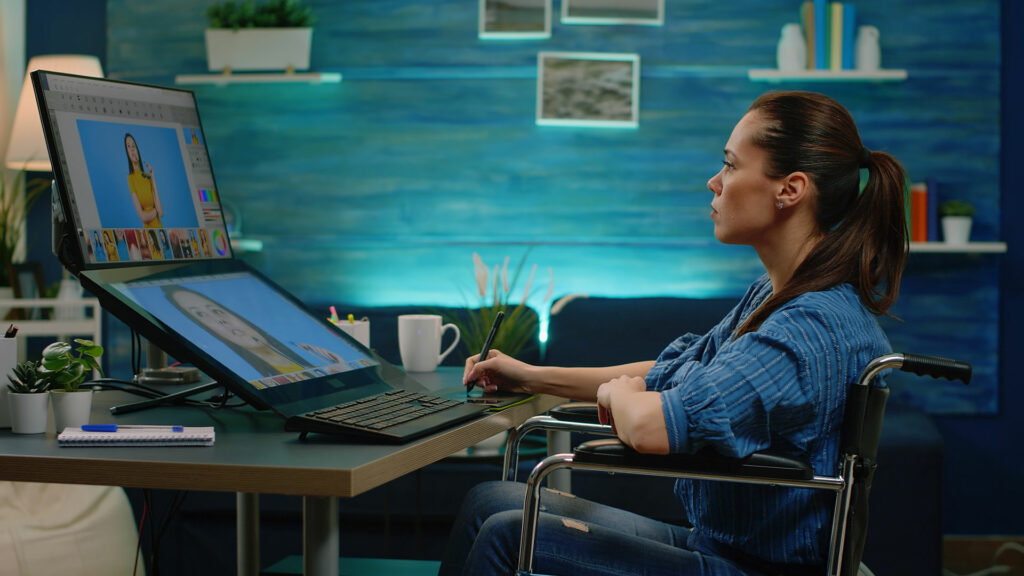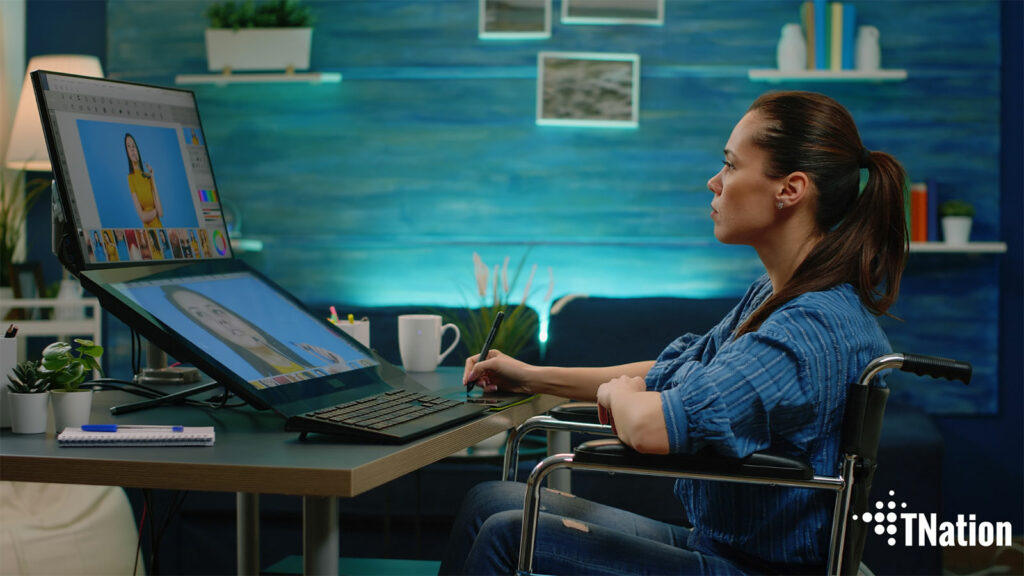Have you ever thought about how people with disabilities use your software? If not, it’s time to start thinking about it! Just think about it. For some reason, you must have had difficulties performing tasks when utilizing someone else’s software. Software accessibility is essential for everyone who uses technology to help them do their jobs more efficiently. Here are ten tips that will help you make sure everyone can use your software.
What Exactly is Software Accessibility?
Software accessibility is not just about making software usable by people with disabilities. Software accessibility is also about making software usable by everyone, including people who use assistive technologies and those who don’t have any problems.
As the simplest example, let’s look at how we can make software accessible. The first thing a user gets acquainted with is the interface. For instance, you have to have a clear and easy-to-use interface. For example, if you have an application that converts currency, it should be easy to use. Users shouldn’t learn how to use the program; they should be able to figure it out independently with minimal effort.
The ease of use of every feature and function of the software is not just about making it available for people with physical impairments. It’s about making it accessible for everyone. Unless you are aiming at a specific group of people, there is software that serves a particular group.
But, if your software is aimed at a broad audience, you have to make it accessible to anyone who wants to use it. Think about the people who would be using your software. People with disabilities. People with different abilities. People with different needs, preferences, and expectations.
10 Simple Tips to Making Software Accessibility a Priority
Tip#1. Your software should be accessible to users with disabilities.
Software accessibility is not just for people with disabilities. Accessibility is essential for everyone, whether you have a disability or not. It’s about making things work well and not just look good.
The best way to start thinking about software accessibility is that most developers and companies consider that software should be accessible only when they are building something new.
But suppose the existing product has been around for years without proper accessibility support. In that case, it’s time to start adjusting so that you can make sure everything works well with assistive technologies like screen readers. Not just occasionally but every time someone uses your product or service!
Tip#2. Simple things such as keyboard shortcuts, color contrast, and text alternatives go a long way.
When designing a software product, there are many things to consider from functionality, visual design, and the audience which uses it. But accessibility must be at the forefront of your mind if you want your product to be usable by everyone.
And as simple as that might seem, it’s not always easy. As developers and designers, we sometimes forget about the inherent challenges of making our products accessible for people with impairments like low vision or hearing loss. We assume that because we don’t have those disabilities ourselves (and our friends don’t), we don’t need to make any changes in our designs or development process—but this assumption is false!
Whether you realize it or not, everyone has some disability or limitation that affects their daily lives. For example, some statistics show that 10% of the population is color blind. There are also ones who have specific preferences. It is not easy, but making sure your software is accessible goes beyond just checking off boxes on an accessibility checklist during development (though those checks should still happen).
In this post, I covered some tips for making sure that people with disabilities can access and enjoy using your software product without harming other users who don’t need any special assistance.
Tip#3. Meet Cross-Platform Software Accessibility Requirements
The main principle of cross-platform software accessibility is to make your product accessible on all the major operating systems. That means your software should run on Windows, Mac OS X, and Linux with minimum effort. All three of these are prevalent computing environments, so it is only natural that a user would want to use them in their daily life.
You want to include as much as mobile devices as you can, but at the same time, each platform has its necessary standards. An excellent example of this is the keyboard shortcuts you use.
On a Windows computer, it is typical to have Ctrl + S as the shortcut for saving a file, while on Mac OS X, it is Command + S. These differences are not a big deal if anyone can use the software you are creating on both operating systems. Still, if an app only runs on one platform, these accessibility issues become much more critical.
It’s important to know that accessibility standards are not barriers to innovation and creativity. On the contrary, they don’t hinder innovation or imagination; they enable them! For example, suppose you want to create a new feature for your product involving user interface elements such as an icon or button.
In that case, it should be accessible by default because the same standard applies regardless of what platform it runs on. If we follow these rules when designing and developing our products, we will have one consistent experience across all platforms (web-, mobile-, desktop-).
Tip#4. It’s important to understand that people with disabilities are your customers too!
As a business owner, you know that your customers are the lifeblood of your company. So you want to ensure they have a great experience with your products and services and with the people who work for you. That’s why it’s essential to understand that people with disabilities are your customers too!
Accessibility is an integral part of doing business for many reasons. But, first and foremost, accessibility is good for business:
- Accessible software attracts more visitors;
- Accessible applications increase revenue;
- Accessible mobile sites boost engagement and reduce bounce rates (the percentage of users who leave without completing tasks).
In addition to these specific benefits, accessibility is also suitable for customers because it enables them to use all of the features provided by your product or service as intended.
For example, suppose someone uses a screen reader or magnifier software on their phone or laptop at home but can’t access those same functions when they visit your website on their device at work or school because it isn’t coded correctly. In that case, you will lose those features forever—and so will any potential new sales opportunities from this customer segment. In addition to these straightforward benefits.
Tip#5. Creating accessible software requires universal design principles.
Creating accessible software requires universal design principles. Universal design is a doctrine that seeks to create products and environments usable by all people to the greatest extent possible. It means designing for diversity, flexibility, and adaptability.
Universal design is a set of principles you can apply to all products, environments, and services. It includes features such as large text and icons, adequate color contrast for people with low vision, sufficient white space for users with cognitive disabilities, and appropriate support for people who rely on assistive technologies.
It means designing for various abilities, needs, and preferences. It means thinking about people with disabilities from the beginning of the design process—not as an afterthought.
Tip#6. Accessibility is not limited to assistive technology software and devices.
Accessibility is not limited to assistive technology software and devices. Accessibility is a design principle that applies to any product, service, or solution you create. When you make sure your software is accessible, it will be easier for everyone—not just those with disabilities—to use it.
If you’re working on an app or website, accessibility means ensuring it works well with different browsers, devices, operating systems, and other settings. For example:
- Make sure your site works with screen readers (software that allows visually impaired people to navigate websites) so they can hear content read aloud or have text highlighted as they move their cursor over the page.
- Make sure your software has keyboard shortcuts and make sure they’re in the user’s guide. The same goes for any other software you create or use with options/settings that users can change. It also makes it easier for anyone who uses touchscreens/touchpad computers when text entry becomes more difficult than usual due to a lack of tactile feedback from typing onto virtual keyboards instead – we’ve all been there!
Tip#7. Web accessibility means more than ensuring your web apps work with accessibility tools.
There are a lot of misunderstandings about what accessibility means. However, in the context of web apps and websites, it also means considering how people interact with your product on different devices and browsers. For example:
- OS may reverse the order of items on a page from one screen to another.
- Links may be hidden or hard to find if they’re not highlighted or underlined.
- Text size is small if you’re using mobile or tablet devices, and there’s no way to zoom in on the text.
- The page layout is very dense, making it challenging to navigate even with a screen reader or any other assistive technology.
Many other factors can affect your website or web app’s work, and you may not even be aware of them. The best way to ensure your product is accessible to everyone is to test it on different devices and browsers before deploying it.
Tip#8. You can make relatively easy changes to your website that will improve its accessibility for everyone.
You can make changes to your website that will make it more accessible for everyone without overhauling the site or rewriting the HTML entirely. You can do many simple things to make your website more accessible, such as:
- Ensuring that the contrast between text and the background color is high enough so that everyone can read it easily.
- Make sure your website works with different screen readers, keyboard shortcuts, and other assistive technologies.
- Ensuring that your website is appropriately coded (using HTML5 and CSS2.1 or higher) to display correctly on all devices.
- Make sure all your images have alt text (alternative text). It is significant for images with nothing on them or just a logo. If there’s nothing else on the page but an image, people who use screen readers won’t be able to understand what the content is about.
- Use headings to organize your content into sections. Screen readers use these headings to help users understand the structure of a page. Search engines also use them to determine what each section is about to get a better rank of your site in searches.
- Use lists to break up large blocks of text into smaller chunks. Lists also help search engines better understand the structure of your content so they can better rank your site in searches.
- Use links to connect related content. This will help screen readers understand your page better and make it easier for people using screen readers to navigate between sections of content.
Tip#9. Make use of Accessibility Testing!
Accessibility testing is a great way to ensure your software or web app is accessible to as many people as possible. By using accessibility testing tools, you can ensure that the same user experience of your product will be available for everyone.
There are several types of testing:
- Manual code review checks involve having an actual person test out your product and report back on their findings.
- Automated checks, use software to test software and websites automatically. However, they lack human intervention, and some accessibility issues might pass unnoticed.
- Visual inspections are commonly known as User experience reviews. They rely more heavily on human eyes than computers—they’re often used to check menu functionality and logical page layout!
- User testing allows real-world people to test software or website and report back on findings.
Tip#10 Don’t let legal issues keep you from making your software as accessible as possible.
Indeed, you are legally required to make your software accessible, but don’t let that scare you. The law is evolving, and as it grows, it will become more precise and easier to understand.
For now, don’t let law and other issues be an excuse not to make your software accessible. Instead, educate about accessibility laws, and make sure you’re following them. You don’t have to be a specialist on the subject; many online resources can help you learn more about accessibility.
Software accessibility is something that helps everyone who uses it!
Accessibility benefits everyone who uses your software: customers, clients, users, and visitors. It can help them achieve their goals more efficiently by making their experience easier to use. And it’s good for business too: companies have reported saving money on support costs by being more accessible in the first place!
Accessibility is not a niche topic—it’s something that affects all of us. If you’re a developer, it’s essential to learn about accessibility and how it can make your software more usable for everyone. If you’re not a professional developer but have a software product in mind, remember that accessibility benefits everyone who uses your software: customers, clients, users, and visitors.
TNation can help you create accessible software that everyone can use.



